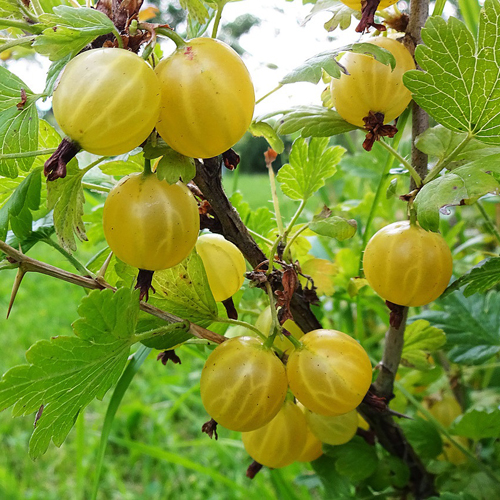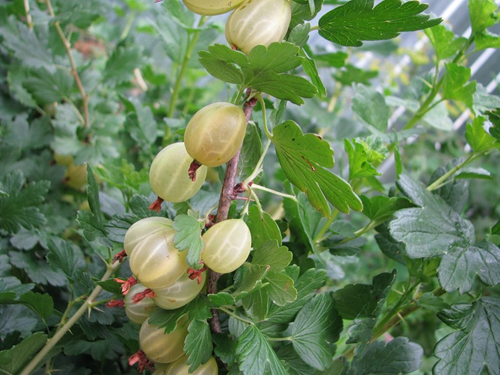Gooseberry variety Amber
The method of free pollination in the development of new varieties has been known for a long time, as it allows you to obtain varieties with excellent characteristics. In gooseberry breeding, a species called Amber was obtained by this method. Its author, M.A. Pavlova, at that time she worked in the experimental farm of the TSKHA (Moscow, Otradnoye). The variety is not new, it was bred in the 50s of the XX century by sowing seeds from free pollination of English yellow gooseberries. From the parental form, Yantarny adopted positive qualities, thanks to which he managed to win the recognition of gardeners. Suitable for production plantings.

Description
The bushes are well developed, semi-spreading, medium-sized, dense. Height is about 1.5 - 1.8 meters. Shoot thorniness is moderate. The thorns are single, small, thin, straight. Slightly leafy shoots. Leaves are light green, small or medium, straight, rounded, leaf lobes are slightly dissected. The teeth are bent in the opposite direction. The surface is smooth, slightly wrinkled, slightly glossy. The base of the sheet is straight. The leaves of the fruits of the variety are curved in the opposite direction, have small curved teeth.
Gooseberries can be called large, their weight is 5 - 6 grams. The shape is elongated-oval, the skin is strong, slightly covered with glandular hairs or smooth. In the process of ripening, the bright yellow color acquires an amber hue, for which the species got its name. The veins are almost white, not too branched. The pulp is light yellow, juicy, with a honey aroma. The taste is good, sweet and sour. Depending on weather conditions, the pulp accumulates from 8.47 to 11.05% of sugars, acids - from 1.66 to 2.34%.
Characteristics
- During the fruiting period, Yantarny enters the field of planting a 2-year-old seedling for 2 years;
- in terms of ripening, the culture is early maturing. In the Central region, the berries ripen by the end of June - early July;
- the yield is simply excellent (the author of the variety M.A.Pavlova paid great attention to this characteristic). Up to 10 kg (more than a bucket) of berries of excellent quality are removed from one bush. According to other sources, this figure is even higher - 11 - 12 kg per bush;
- when ripe, the dense skin protects the gooseberries from cracking, even in rainy weather;
- ripe fruits do not crumble, hang on branches for a long time, do not overripe;
- plant immunity is high - spheroteka (American powdery mildew) is practically not affected. But resistance to white spot is not very good;

- gooseberry winter hardiness is high, there is information that the culture is able to safely survive frosts at -40 ° C. The branches do not freeze;
- drought resistance of the variety is good;
- Amber belongs to long-livers and is able to fruitfully live in one place for more than 30 years;
- transportability at a high level - the presentation of the crop is not lost during transportation;
- the purpose of the berries is dessert, the method of use is universal. The fruits are suitable for jam, making marmalade, jelly, wine.
Planting and leaving
The described variety is unpretentious to soils, it can grow well on loams, sandstones and sandstones. But it does not tolerate cold, swampy and acidic soils. Be sure to choose a place for gooseberries that is sunny (even in partial shade, the berries of Amber will become smaller and sour), the site should be free of weeds. The best predecessors are legumes that enrich the soil with nitrogen. The variety responds to the introduction of organic matter by increasing the growth of young shoots and increasing the yield. Watering on time has a beneficial effect on the fruiting of this year and stimulates the laying of fruit buds of the future harvest.Pruning is carried out in order to thin out the bush and stimulate the growth of young shoots. The most productive are 3 - 4-year-old branches, 6-year-old branches no longer give growth and, as a rule, dry out. Planting is best done in the fall, since the culture starts to grow in spring very early, which is why you may simply not have time to meet the deadlines. In the southern regions, seedlings are planted in late October or early November. If you choose a spring planting, then you need to carry it out very early - you can even in February "windows", while the buds are sleeping.
Amber is an unpretentious and undemanding gooseberry, at the same time very fruitful. Resistance to spheroteca is an important quality, since it is this disease that can destroy a culture. Another significant plus is high winter hardiness. When considering new varieties for your garden, do not forget about the old, time-tested varieties.









Among the four varieties of gooseberries that grow on my site, I consider Amber the best in the sense that it is unpretentious, the fruits ripen much earlier than others, there are a lot of them and they are unusually sweet. This makes it possible to save on sugar when making jams. In addition, the bush is very prolific.
This gooseberry is also very easy to breed. It is enough to dig a layer from the bush into the ground, as next year it can already grow on its own. Cutting is not very effective, but it is also possible.
The only drawback in growing gooseberries (this can probably be attributed to all varieties) is the bloom of powdery mildew on the fruits. Most often, it appears in rainy weather. If you do not process the bush in time, then later, in order to use the berries in the preparation of conservation, you will have to tinker with cleaning the fruits. I process it with copper sulphate 2 - 3 times and my gooseberries always give an excellent harvest.